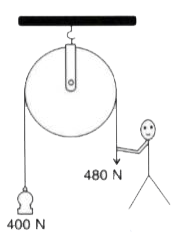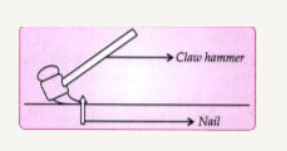Mechanical advantage
Step-by-Step Solution:
1. Understanding Mechanical Advantage: Mechanical advantage is a concept used in physics to describe how much a machine amplifies the force applied to it. It helps us understand how simple machines like levers, pulleys, and inclined planes make work easier.
2. Defining Mechanical Advantage: The mechanical advantage (MA) is defined as the ratio of the load (the weight or resistance that is being moved) to the effort (the force applied to move the load).
3. Mathematical Expression: The formula for mechanical advantage can be expressed as:
Mechanical Advantage (MA)=LoadEffort
4. Units of Mechanical Advantage: Since mechanical advantage is a ratio of two forces (load and effort), it does not have any units. This means that it is a dimensionless quantity.
5. Conclusion: In summary, mechanical advantage is a measure of how effectively a machine can amplify an input force. It is calculated by dividing the load by the effort, and it is a unitless ratio.
---
Mechanical Advantage (MA)=LoadEffort
Topper's Solved these Questions
- ENERGY BOOK - ICSECHAPTER - ENERGY EXERCISE - Exercises Section II (Distinguish between the following)
2 Videos
- ENERGY BOOK - ICSECHAPTER - ENERGY EXERCISE - Exercises Section II (Short answer questions)
5 Videos
- ENERGY BOOK - ICSECHAPTER - ENERGY EXERCISE - Exercises Section II (Give reasons for the following)
5 Videos
- FORCEBOOK - ICSECHAPTER - FORCEEXERCISE - Picture Based Questions
2 Videos
Similar Questions
The adjacent Figure shows a fixed pulley used by a boy to lift a load of 400 N through a vertical height of 5 m in 10 s. the effort applied by the boy on the other end of the rope is 480 N.

(a) What is the velocity ratio of the pulley ?
(b) What is the mechanical advantage ?
(c) Calculate the efficiency of the pully.
(d) Why is the efficiency of the pulley not 100% ?
(e) What is the energy gained by the load in 10 s?
(f) How much power was developed by the boy in raising the load ?
(g) The boy has to apply an effort which is greater than the load he is lifting. what is the justification for using the pulley ?
View SolutionThe diagram below shows a lever in use.

(a) To which class of lever does it belong ? Give one example of this class.
(b) How will the mechanical advantage of lever change if load is shifted towards the fulcrum without changing it's dimensions.
View SolutionFigure below shows a lever in use

(a) To which class of levers does it belongs ?
(b) Without changing the dimensions of the lever, if the load is shifted towards the fulcrum what happens to the mechanical advantage of the lever ?
View SolutionDraw a labelled diagram of an arrangement of two pulleys, one fixed and other movable. In the diagram, mark the directions of all forces acting on it. What is the ideal mechanical advantage of the system ? How can it be achieved ?
View SolutionA lever of length 9 cm has its load arm 5 cm long and the effort arm is 9 cm long. (a) to which class does it belong ?
(b) Draw a diagram of the lever showing the position of the fulcrum F and directions of both the load L and effort E. (c) what is the mechanical advantage and velocity ratio if the efficiency is 100%?
(d) What will be the mechanical advantage and velocity ratio if the efficiency becomes 50%?
View SolutionGive reasons for the following:
(a) In a single fixed pulley, the velocity ratio is always more than the mechanical advantage.
(b) The efficiency of a movable pulley is always less than 100%.
(c) In case of a block and tackle system, the mechanical advantage increases with the increase in the number of pulleys.
(d) The lower block of a block and tackle pulley system must be of negligible weight.
View SolutionA pulley system has a velocity ratio 3. draw a diagram showing the point of applicationi and direction of load (L), effort (E) and tension (T). It lifts a load of 150 N by an effot of 60 N. calculate its mechanical advantage. Is the pulley system ideal ? Give reason.
View SolutionIn Figure, draw a tackle to lift the load by applying the force in downward direction.
(a) Mark in the diagram the direction of load L and effort E.
(b) If the load is raised by 1 m, through what distance will the effot move ?
(c) State the number of strands of tackle supporting the load.
(d) What is the mechanical advantage of the system?

View SolutionDraw a diagram of a combination of three movable pulleys and one fixed pulley to lift up a load. In the diagram, show the directions of load, effort and tension in each strand. Find : (i) the mechanical advantage, (ii) the velocity ratio, and (iii) the efficiency of the combination, in the ideal situation.
View SolutionThe diagram below shows a claw hammer used to remove a nail :

(i) To which class of lever does it belong?
(ii) Give one more example of the same class of lever mentioned by you in (i) for which the mechanical advantage is greater than one.
View Solution
